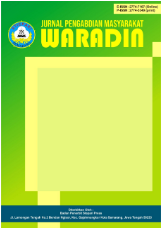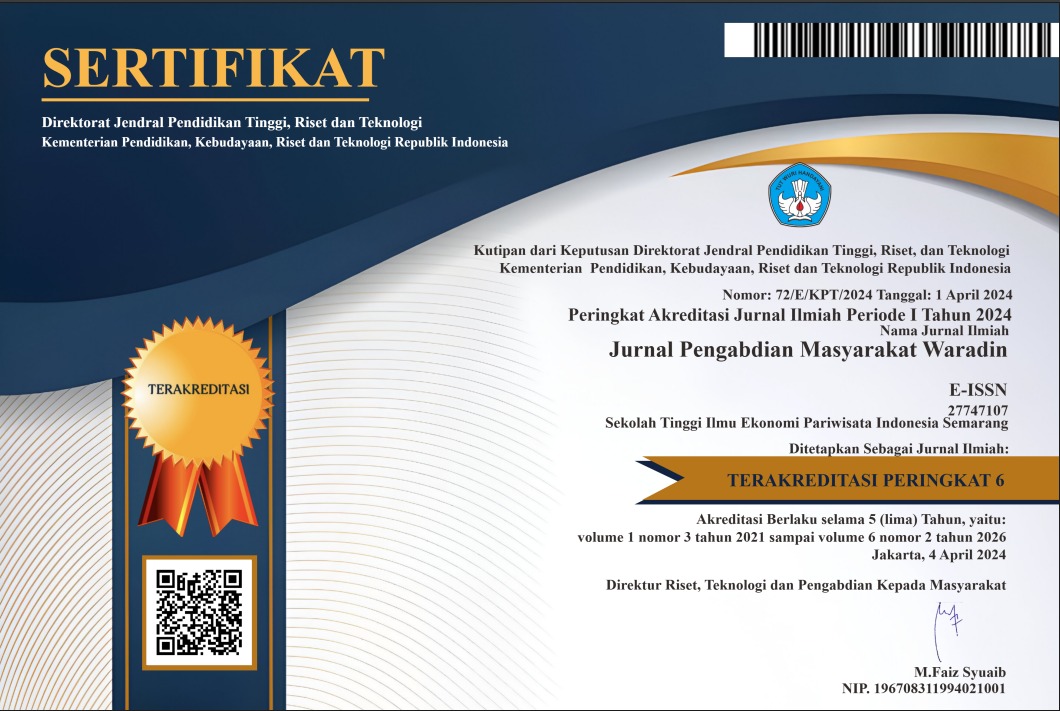Pemasangan Lampu Panel Surya Sederhana sebagai Solusi Penerangan yang Ramah Lingkungan di Taman Rukun Warga
DOI:
https://doi.org/10.56910/wrd.v5i2.742Keywords:
Community Park, Outdoor Lighting, Renewable Energy, Solar Energy, SustainabilityAbstract
Outdoor lighting, such as in community parks, plays a crucial role in supporting community activities at night while enhancing safety and comfort. Unfortunately, traditional electricity usage is often inefficient and has negative environmental impacts due to carbon emissions from fossil fuel-based power plants. This study aims to implement solar panel technology as an environmentally friendly lighting solution in Taman RukunWarga, located in Kelurahan Bendung, Kecamatan Kasemen, Kota Serang. The methods applied in this study include site surveys, assembly of the solar-powered lighting system, and performance analysis after installation. The lighting system consists of a 30 Wp solar panel, a battery (accumulator), a solar charge controller, a 12V 20W DC LED light, and other supporting components. The results show that this system can provide adequate and even lighting for the park area while being energy-efficient. One of the main advantages of this system is its ability to reduce operational costs by using renewable solar energy and requiring minimal maintenance. Additionally, the implementation of this solar-powered lighting system has increased public awareness of the importance of utilizing renewable energy and reducing carbon emissions in the surrounding environment. Overall, the installation of this solar-powered lighting system has proven to be a sustainable, energy-efficient, and environmentally friendly alternative for meeting lighting needs in community parks. This system not only reduces dependence on fossil fuels but also contributes to efforts to mitigate negative environmental impacts. By utilizing solar energy, this system serves as a positive example of the application of renewable energy technology in daily life, while helping to create a cleaner and healthier environment for the community.
References
Badan Standardisasi Nasional (BSN). (2019). SNI 04-6958-2003: Sistem Energi Surya Fotovoltaik - Instalasi dan Pemeliharaan. Jakarta: BSN.
BPPT. (2020). Pedoman penerapan teknologi energi surya di permukiman. Jakarta: BPPT Press.
Budiarto, M., & Syarifuddin, S. (2021). Pengembangan teknologi hemat energi berbasis panel surya untuk wilayah sub-urban. Jurnal Teknologi Terapan, 8(3), 44-50.
Global Solar Atlas. (2021). Indonesia solar resource map. Retrieved from https://globalsolaratlas.info
Handayani, K., Krozer, Y., & Filatova, T. (2017). From fossil fuels to renewables: An analysis of long-term energy transitions in Indonesia. Renewable and Sustainable Energy Reviews, 76, 107-116.
Irawan, Y., & Dwinanto, A. (2018). Penggunaan lampu LED DC berbasis panel surya di area publik. Jurnal Teknologi Elektro, 9(1), 31-37.
International Renewable Energy Agency (IRENA). (2020). Renewable power generation costs in 2020. Abu Dhabi: IRENA.
Kementerian Energi dan Sumber Daya Mineral Republik Indonesia. (2022). Potensi energi surya di Indonesia. Retrieved from https://www.esdm.go.id
Mulyadi, R., & Rahayu, L. (2020). Model edukasi energi terbarukan berbasis komunitas lokal. Jurnal Pengabdian kepada Masyarakat, 5(1), 77-84.
Mujiyanto, S., & Tiess, G. (2013). Secure energy supply in 2025: Indonesia's need for an energy policy strategy. Energy Policy, 61, 31-41. https://doi.org/10.1016/j.enpol.2013.05.119
Nugroho, A. A., & Wicaksono, A. (2021). Pemanfaatan penerangan jalan umum tenaga surya (PJU-TS) dalam mewujudkan kota berkelanjutan. Jurnal Teknik ITS, 10(1), A74-A79.
Prasetyo, H., & Arifin, R. (2022). Evaluasi sistem penerangan jalan berbasis solar panel. Jurnal Ilmu Teknik Elektro, 11(2), 85-93.
Putri, D. A., & Ramadhan, F. (2021). Implementasi solar cell sebagai energi alternatif pada rumah tangga. Jurnal Teknologi dan Inovasi, 5(2), 60-68.
Rahmawati, A., & Yusuf, R. (2019). Perbandingan efisiensi panel surya polycrystalline dan monocrystalline di wilayah tropis. Jurnal Energi Baru dan Terbarukan, 4(1), 10-16.
Sopian, K., & Othman, M. Y. H. (2016). Solar energy for the future. International Journal of Renewable Energy Research (IJRER), 6(4), 1411-1415.
Sulistiyono, D. (2020). Teknologi terbarukan untuk kemandirian energi nasional. Yogyakarta: Deepublish.
Wahyudi, D., & Sari, R. (2019). Desain dan implementasi sistem penerangan jalan menggunakan panel surya untuk daerah terpencil. Jurnal Teknologi dan Sistem Komputer, 7(3), 104-110.
Wahyuningsih, S. (2022). Pemanfaatan teknologi sederhana untuk penerangan berkelanjutan di pedesaan. Jurnal Energi dan Teknologi Lingkungan, 3(2), 58-65.
Wibowo, A. H., & Suryani, N. (2018). Penerapan teknologi panel surya di lingkungan masyarakat pedesaan. Jurnal Inovasi Teknologi, 3(1), 23-29.







